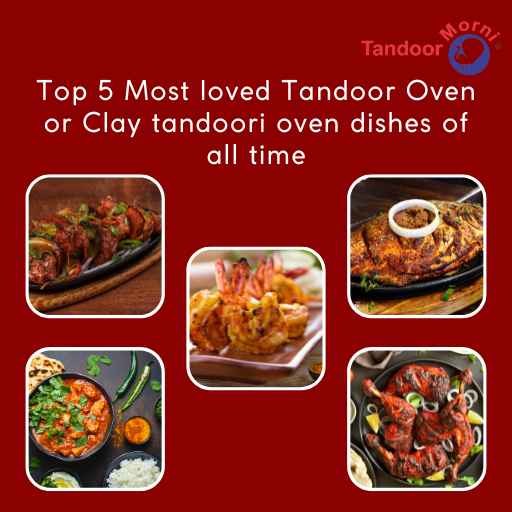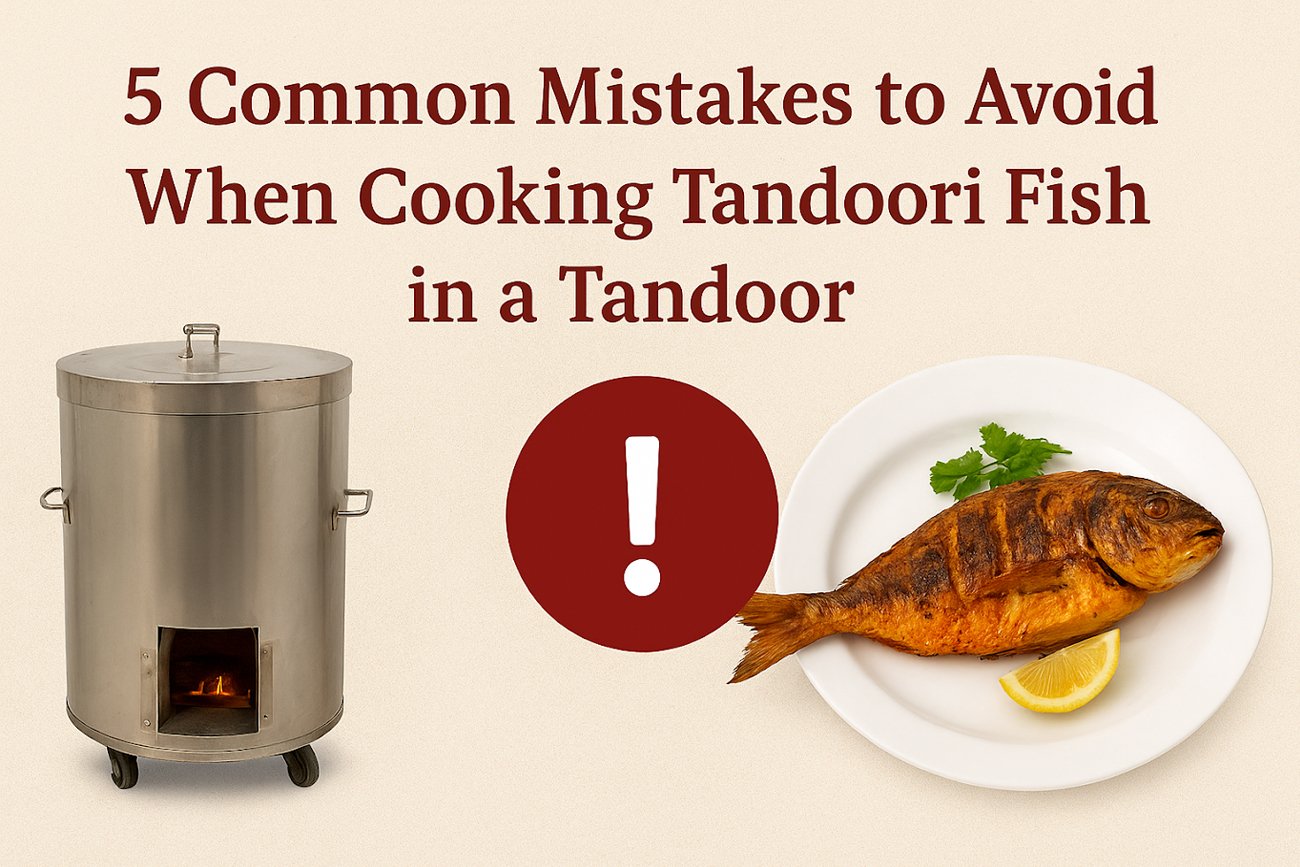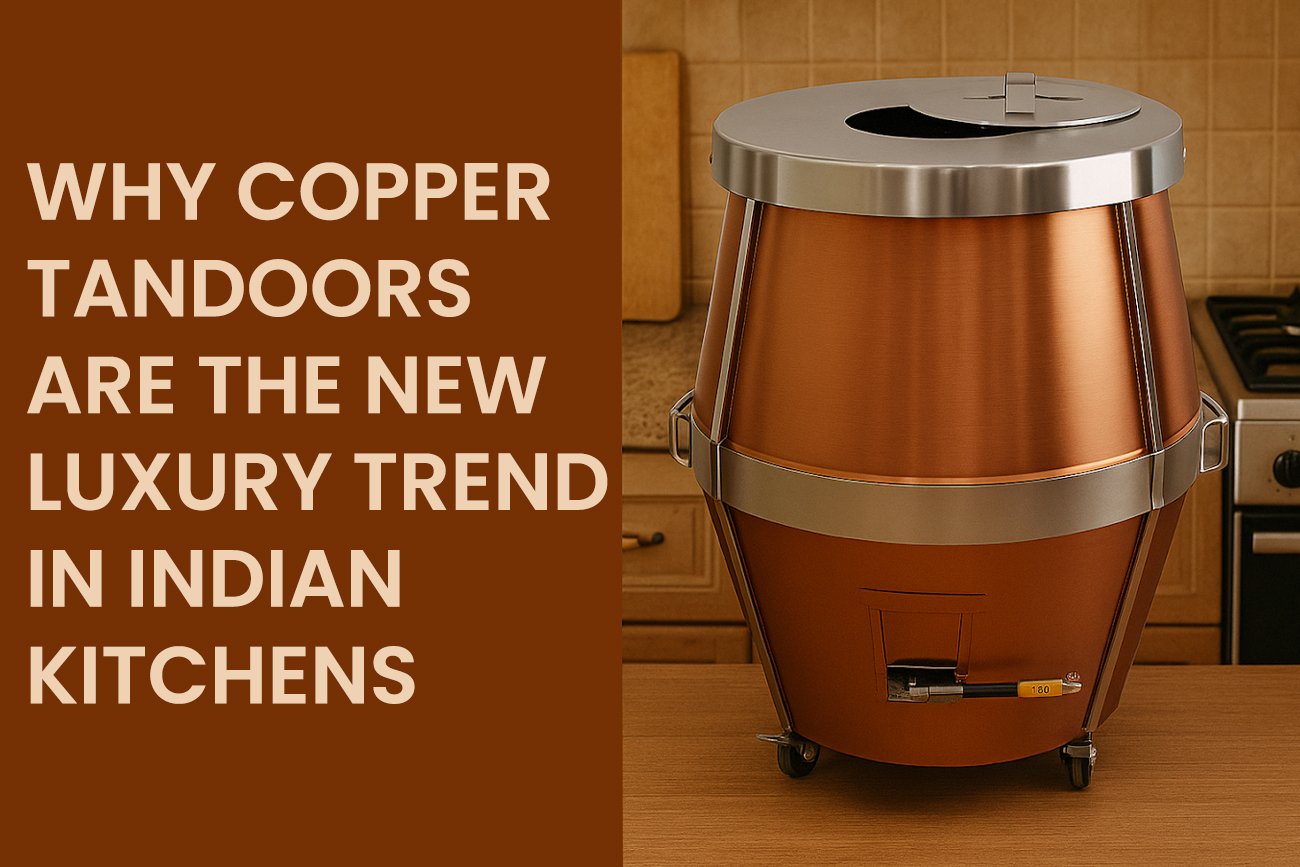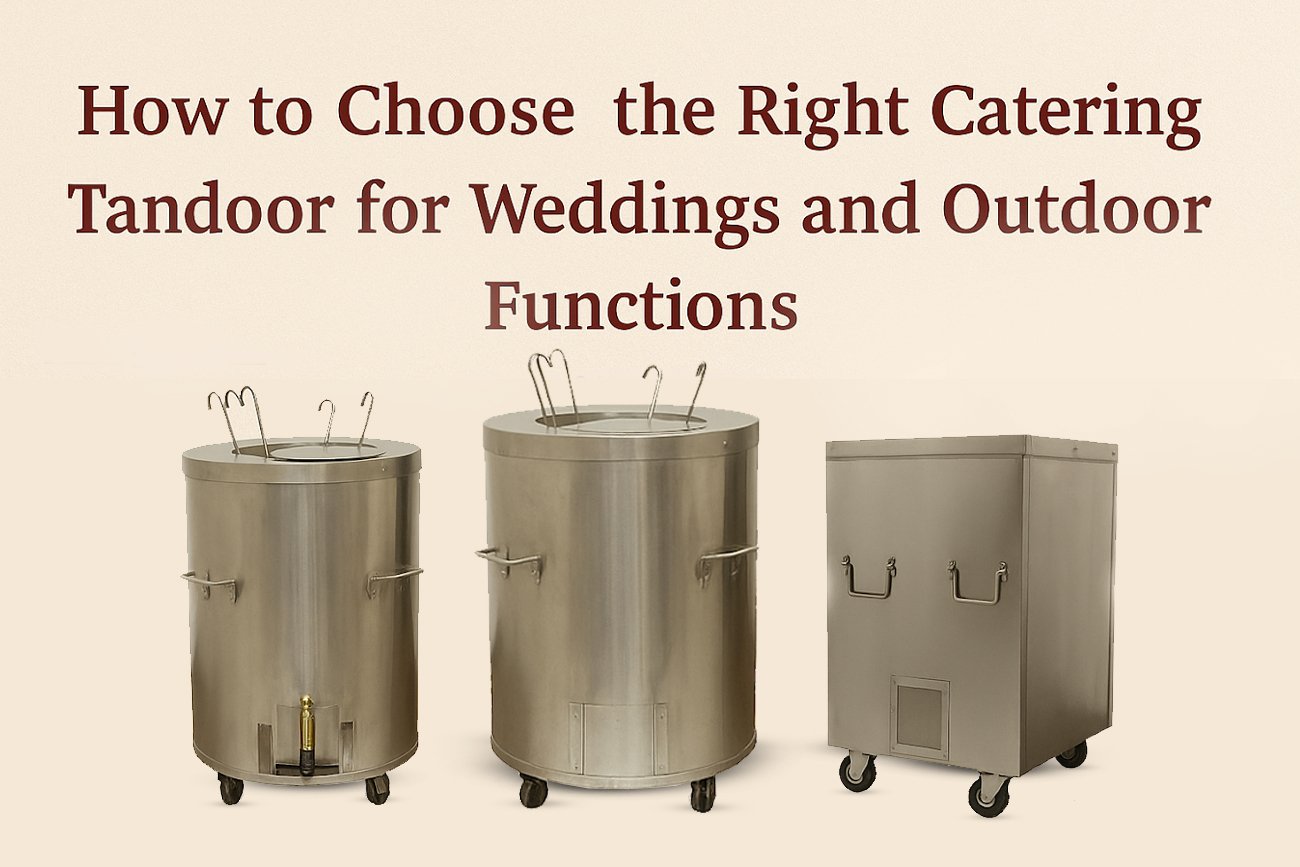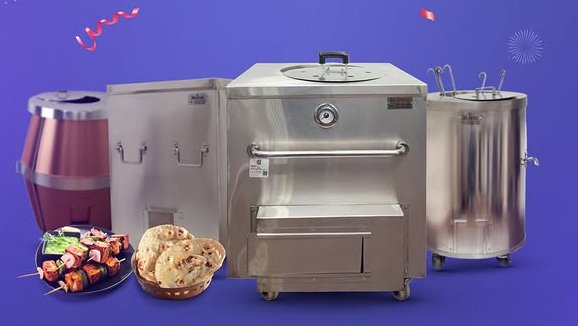
Square Tandoor vs. Round Tandoor: Which One Is Right for You?
If you love the smoky flavor of tandoori cooking, a tandoor oven could be a perfect addition. You might be deciding between Square Tandoors or Round Tandoors for your kitchen or outdoor space. Both types of tandoors offer unique benefits, but they serve slightly different purposes. Choosing the right one for your needs comes down to understanding how each style of tandoors fits into different settings, their designs, and how they perform. Let’s explore these two types of tandoors in more detail so you can make the best choice for your tandoori cooking experience.
Why Tandoors Are Loved Worldwide
Before diving into the specifics of square tandoors and round tandoors, it’s helpful to understand why tandoor ovens are popular worldwide. Indian, Middle Eastern, and Central Asian cuisines mainly use a tandoor, a traditional clay oven. It can reach very high temperatures, cooking food quickly while sealing in moisture and flavor. The result is deliciously charred meats, crispy bread, and smoky vegetables. Today, tandoors are used in homes, restaurants, and catering services, bringing authentic flavors to a variety of dishes.
Square Tandoor: The Preferred Choice for Restaurants
If you’ve ever seen a tandoor in action at an Indian restaurant, it was likely a square tandoor. Square tandoors are popular in restaurant kitchens because they fit well with commercial kitchen equipment, often square or rectangular. This shape allows easy placement alongside other appliances, making it practical for busy kitchens.
Why Are Square Tandoors Ideal for Restaurants?
-
- Fits With Commercial Kitchen Equipment: In professional kitchens, most equipment is square or rectangular in shape. A square tandoor can easily be positioned alongside other appliances, saving space and making the layout more efficient.
-
- Extra Storage Space on Top: Square tandoors provide additional space on top for keeping grilling skewers, spices, or other tools. This feature is particularly helpful in a restaurant where space is limited, and chefs need everything within easy reach.
-
- Dual-Insulated Design for Longer Durability: Square tandoors often feature dual-insulated layers that retain heat effectively. This design reduces charcoal or gas consumption and keeps the exterior cooler, enhancing safety in a busy kitchen.
-
- Built for Heavy Use: The sturdy design of square tandoors makes them more durable for heavy daily use. This durability is essential for restaurants that serve tandoori dishes frequently.
Round Tandoor: Perfect for Home Kitchens and Small Gatherings
For home chefs, caterers, or anyone who loves backyard barbecues, a round tandoor is often the better choice. These tandoors are usually lighter and easier to move, making them great for outdoor use or small events. If you’re looking to add a touch of traditional cooking to your home, a round tandoor offers the perfect blend of convenience and authenticity.
Why Choose a Round Tandoor for Home Use?
-
- Lightweight and Portable: Round tandoors are portable, making them easy to move around your backyard, patio, or even take to gatherings.
-
- Popular for Events: This portability is ideal for caterers and event planners who need a transportable cooking solution.
-
- Perfect for Outdoor Cooking: The lighter design suits outdoor settings, whether for a barbecue, small event, or family get-together.
-
- Traditional Appeal: Round tandoors add a traditional cooking element to any occasion, enhancing the experience.
-
- Great for Families and Events: With various sizes available, small models suit family meals, while larger ones fit small events without occupying much space.
Comparing Square Tandoor and Round Tandoor Designs
Choosing between a square and round tandoor? Knowing their design differences will help you make the best choice. Let’s look at the key design features of each.
Square Tandoor Design Features
-
- Dual-Insulated Build: Square tandoors typically have a dual-insulated structure, meaning they include two layers of insulation. This design keeps the heat inside while keeping the exterior cooler, which is especially important in restaurant kitchens where safety is a priority.
-
- Ceramic Insulation Layer: Inside the tandoor, there is often a ceramic insulation layer that acts as a barrier between the clay oven and the steel body. This helps the oven heat up quickly and maintain a steady temperature, making it more efficient and using less fuel.
-
- Stainless Steel Exterior: Square tandoors are usually made with a stainless steel exterior, which gives them a sleek look and adds durability. The steel top converges into the mouth of the tandoor, allowing skewers to rest on the stainless steel rather than the clay, which can extend the life of the tandoor.
Round Tandoor Design Features
-
- Single-Insulated Structure: Unlike square tandoors, round tandoors typically have a single-insulated design. This makes them lighter and easier to handle. Although they may not retain heat as well as their square counterparts, they are still effective for home and outdoor use.
-
- Optional Heavy Stainless Steel Top: Some round tandoors come with the option of a heavy stainless steel top, which provides extra stability and helps distribute heat evenly. This feature is particularly useful for larger models used in catering.
-
- Classic Clay Oven Style: Round tandoors maintain the traditional look and feel of a classic clay oven, which appeals to many people who want an authentic tandoori cooking experience.
How to Choose the Right Tandoor Based on Your Needs
Choosing between a square tandoor and a round tandoor depends on where you plan to use it, how often you will cook with it, and your personal preferences. Here’s a simple guide to help you decide:
If You Run a Restaurant
-
- Go for a square tandoor. The square shape fits well with other equipment and provides more storage space on top.
-
- The dual-insulated design ensures the exterior stays cool, making it safer in a busy kitchen.
-
- Its sturdy build can handle heavy daily use without wearing out quickly.
If You Need a Tandoor for Home Use or Small Events
-
- Choose a round tandoor. Its lightweight design makes it easy to move around, and it fits well in smaller spaces like a backyard or patio.
-
- If you’re a caterer who frequently moves the oven, a round tandoor will be more practical due to its portability.
-
- Opt for a model with an optional heavy top if you plan to use it for larger events.
The Role of Tandoor Shape in Cooking Performance
The shape of the tandoor not only affects where you can use it but also plays a role in how it performs. Let’s break down how the shape impacts the cooking experience.
How Square Tandoors Perform in Restaurants
-
- Consistent Heat Distribution: The dual insulation and square shape help keep the heat steady inside, making it ideal for cooking a variety of dishes in a restaurant setting.
-
- More Grilling Space: Square tandoors often have more space on the top for storing skewers, which can be useful during busy service times.
-
- Longer Lifespan: Because of the reduced heat emission and dual-insulated design, square tandoors can last longer even with frequent use.
How Round Tandoors Perform for Home Cooking
-
- Quick to Heat Up: The single-insulated design allows the round tandoor to heat up quickly, making it convenient for spontaneous cooking.
-
- Traditional Flavor: The classic clay structure enhances the smoky flavor of the food, giving it that authentic tandoori taste.
-
- Ideal for Lightweight Dishes: Since round tandoors are usually smaller and lighter, they work best for cooking lighter dishes like vegetables, seafood, or small portions of meat.
Aesthetics and Personal Preference: Square or Round?
The appearance of your tandoor may not affect its cooking abilities, but it does matter if you care about aesthetics. Some people prefer the traditional look of a round tandoor, while others find the sleek design of a square tandoor more appealing. Here are a few factors to consider when choosing based on appearance:
-
- Round Tandoors Offer a Classic Look: If you want your tandoor to look like it came straight out of a traditional Indian kitchen, a round tandoor is a great choice. The curved shape is visually pleasing and adds a touch of authenticity to any space.
-
- Square Tandoors Have a Modern Appearance: Square tandoors look sleek and stylish with their stainless steel exteriors. They match well with other modern kitchen equipment and have a clean, professional look.
Ultimately, the choice between a square tandoor and a round tandoor comes down to personal preference. Both styles are made by skilled workers and perform well for their intended purposes.
Why Insulation Matters in Tandoor Ovens
The insulation of a tandoor oven plays a big role in how it performs. Let’s look at the differences in insulation between square and round tandoors and why it matters.
Dual-Insulated Square Tandoors
-
- Heat Retention: The dual insulation helps retain heat inside the tandoor, making it more efficient and reducing the amount of fuel needed.
-
- Safer to Handle: The outside of a dual-insulated tandoor stays cooler, which is important in a busy kitchen where safety is a concern.
-
- Longer-Lasting: Reduced heat emission means less wear and tear on the tandoor, leading to a longer lifespan.
Single-Insulated Round Tandoors
-
- Quick Heat-Up Time: Single insulation allows the tandoor to heat up faster, which can be an advantage if you’re cooking on the go.
-
- Lightweight and Easy to Move: Because they are single-insulated, round tandoors are lighter and more portable, making them a great choice for caterers or backyard chefs.
-
- Slightly Lower Heat Retention: While they heat up quickly, they may not retain heat as long as dual-insulated tandoors, which means more frequent fuel replenishment might be needed during long cooking sessions.
How Tandoor Size Affects Cooking Capacity
Both square tandoors and round tandoors come in different sizes, but the size options don’t greatly change the cooking capacity. The cooking space inside remains similar across various models, with slight differences in height. This means you can choose a smaller or larger tandoor based on the number of people you need to serve without compromising on cooking performance.
Small Tandoors for Home Use
-
- Ideal for cooking meals for 2-4 people.
-
- Can be used for small family gatherings or intimate dinner parties.
Medium Tandoors for Small Events
-
- Suitable for cooking for up to 10 people.
-
- Perfect for backyard barbecues or small catering events.
Large Tandoors for Catering
-
- Great for catering larger gatherings, events, or festivals.
-
- Can cook multiple dishes at once to serve a bigger crowd.
Tandoor Material and Construction: What You Need to Know
The material and construction of a tandoor affect not only its appearance but also its durability and performance. Here’s a closer look at the construction features of both square tandoors and round tandoors:
The Construction of Square Tandoors
-
- Stainless Steel Exterior: Square tandoors are built with a stainless steel outer layer that adds durability and gives a sleek, modern appearance.
-
- Ceramic Insulation: Between the clay oven and the steel body, there is usually a layer of ceramic insulation that helps keep the heat in and the outside cooler.
-
- Dual-Layer Insulation: The two layers of insulation help the tandoor maintain a steady temperature and use less fuel.
The Construction of Round Tandoors
-
- Classic Clay Structure: Round tandoors stay true to the traditional clay design, which is great for those who want an authentic cooking experience.
-
- Single Insulation: Round tandoors are usually single-insulated, making them lighter and easier to transport.
-
- Optional Heavy Stainless Steel Top: Some models offer an optional heavy stainless steel top for better heat distribution and stability.
Price Differences Between Square and Round Tandoors
When it comes to price, there is often only a slight variation between square tandoors and round tandoors. The difference is usually due to the level of insulation, the materials used, and the design features like heavy tops or extra storage space. For those who plan to keep the tandoor in one spot, the choice might come down to personal preference. However, if you need to move the tandoor frequently, a round tandoor might be more practical due to its lighter weight.
Final Thoughts: Choosing the Right Tandoor
Whether you go with a square tandoor or a round tandoor, both options offer an authentic and enjoyable cooking experience. Your decision will likely depend on where you plan to use the tandoor, how often you will cook with it, and your personal style preference.
-
- Square Tandoors Are Best for Restaurants: They fit well with other equipment and offer more grilling space and better insulation.
-
- Round Tandoors Are Ideal for Home and Outdoor Use: They are lightweight, portable, and bring a traditional touch to your cooking.
Remember, the most important thing is to choose a tandoor that fits your needs and makes your tandoori cooking experience enjoyable. Both square tandoors and round tandoors deliver delicious, smoky, and flavorful dishes that you’ll love sharing with family and friends.
Need Help? Order and Technical Support
Have questions or ready to place an order? Reach out to us via phone at +1(727) 251 6924 or email us at info@tandoormorni.com.
Need detailed instructions? Explore the Operation Manual for our CH & CS models to get started with your Tandoor oven today.
About Tandoor Morni
Tandoor Morni, in business since 1992, is a trusted name in premium Tandoori Clay Ovens, known for crafting high-quality traditional and commercial tandoors. With a commitment to excellence, Tandoor Morni offers a wide range of tandoors, including commercial, residential, catering, and copper models. Our tandoors are built with durable materials and designed for efficient heat distribution, ensuring authentic flavors and fast cooking. Each oven features customizable options like gas, wood fire, or charcoal compatibility, making them suitable for various cooking needs.
Common Queries – FAQ’S
Can I use a tandoor Indoors?
Yes, certain tandoor models are designed for residential use, including compact, home-friendly versions. However, using a tandoor indoors requires proper ventilation and adherence to safety precautions to manage high heat and potential smoke. Always consult the manufacturer’s guidelines to ensure safe indoor use. For best results, they are often used in well-ventilated spaces or outdoors.
Are Tandoor-Cooked Foods Healthy?
Yes, tandoor-cooked foods are often considered healthy because they typically require little to no oil. The high cooking temperatures allow the food to cook quickly, preserving nutrients while reducing the need for additional fats. Additionally, the vertical cooking method allows excess fats to drip away, resulting in leaner dishes.
What Types of Fuel Can Be Used in a Tandoor?
Tandoors can be heated using charcoal, wood, natural gas or propane. Charcoal and wood provide an authentic smoky flavor, while natural gas or propane is more convenient and easier to control. The choice of fuel often depends on the specific cooking requirements and local regulations, especially in commercial settings.
How Does a Tandoor Oven Differ from a Conventional Oven?
Unlike conventional ovens, which use electric or gas heat, a tandoor is made from clay and uses charcoal, wood, or gas to heat the walls. The cylindrical shape and porous clay walls create an environment where heat circulates evenly, cooking food quickly while adding a smoky flavor. Conventional ovens, in contrast, lack the intense heat and unique cooking technique of a tandoor.
How Much Maintenance Does a Gas Tandoor Require?
Gas Tandoor needs regular maintenance, though less than Charcoal Tandoor models. Here’s a breakdown:
- Daily Maintenance: Wipe down the inner chamber and clean the burner.
- Weekly Maintenance: Check the burner and gas line for any blockages or leaks.
- Monthly Maintenance: Deep clean the gas pipes, burners, and inner chamber.
- Quarterly Maintenance: Have a professional inspect the gas connections and burners.
- Annual Maintenance: Perform a full inspection and reapply clay lining if needed.
Avoid exposing the tandoor to excessive water, and gradually increase heat to prevent cracks.
How Can I Make a Payment for My Tandoor Order?
You can pay for your tandoor order through our website by placing an online order using the available payment options. If you prefer to place an order over the phone, we accept payment via Zelle for a quick and secure transaction.
Which Tandoor Oven Size Should I Choose?
- For Home Use: Consider the number of family members or guests you typically serve. A mini tandoor is ideal for smaller gatherings.( Suggested Product: R26 )
- For Restaurants: Measure the entrance to ensure the oven fits through the door. Select a size based on available space and cooking needs. (Suggested Product: CH02)
- For Naan Bread: Opt for an oven with a smaller mouth opening, resulting in a more egg-shaped clay pot, perfect for naan preparation. For larger meat portions, choose a bigger oven to maintain heat longer. (Suggested Product: CH04)
- For Catering: A Clay Tandoor Oven is suitable for catering due to its lightweight and easy transport features. (Suggested Product: CS01)
- For Banquet Halls: A larger oven with a spacious clay pot is ideal for preparing multiple dishes quickly during big events. (Suggested Product: CH06)
- For Open Kitchens or Outdoor Patios: Choose a model with a decorative finish, such as a copper tandoor, to enhance the kitchen’s appearance with a touch of elegance. (Visit Our Copper Tandoor).
What Should You Consider When Installing a Restaurant Clay Oven?
- When installing a tandoor in your restaurant kitchen, consider the following:
- Space and Placement: Ensure there is enough clearance around the tandoor for ventilation and safety, with fireproof or heat-resistant flooring.
- Ventilation and Exhaust: Proper ventilation is essential to handle heat and smoke, especially with charcoal tandoors.
- Safety Measures: Use heat-resistant barriers if the tandoor is near other equipment, and keep fire safety equipment like extinguishers handy.
- Fuel Supply: Decide between charcoal, which offers traditional flavors, and gas, which is easier to manage.
By keeping these points in mind, you can ensure a safe and efficient tandoor setup. If you're looking for a Restaurant Clay Oven for Sale, make sure to choose a model that fits your kitchen's requirements and meets all necessary safety standards.
- Menu Considerations: Larger tandoors or multiple units may be needed if you have a diverse menu or high demand during peak hours.
- Maintenance and Cleaning: Clean the tandoor daily and monitor for any wear or damage to the clay or gas parts.
- Compliance with Regulations: Ensure your installation meets local safety standards and health codes.
- Staff Training: Train staff in safe tandoor operation and fire safety protocols.


